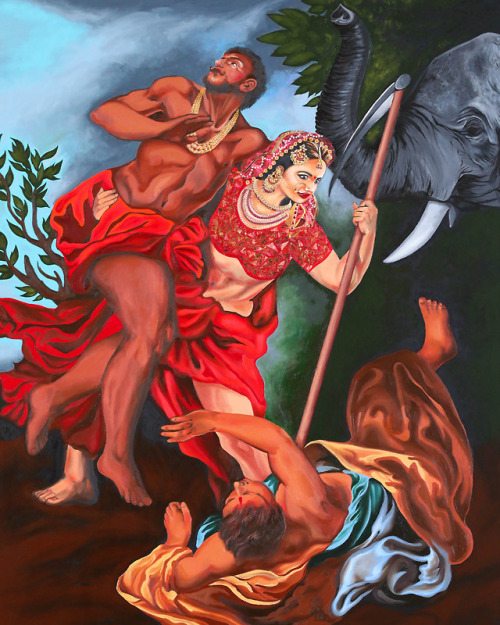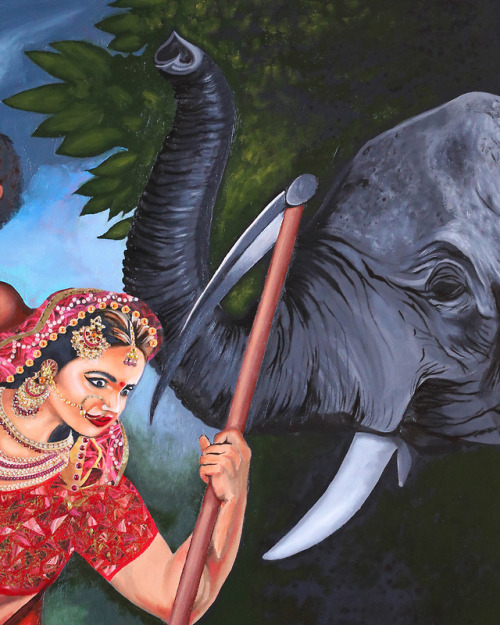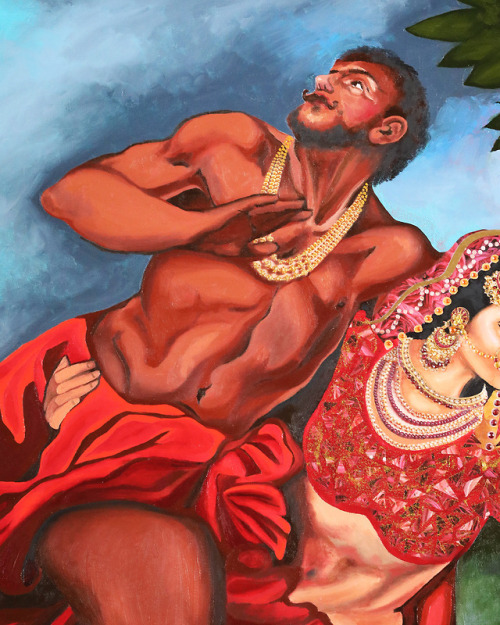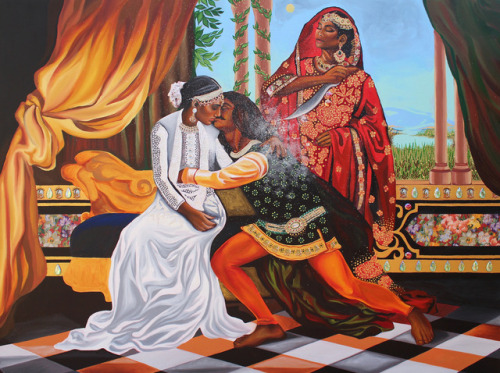#desi remix
“Indrani”
Part 8 & the final piece of the ‘Desi Remix’series.
[Remix of Time Saving Truth From Falsehood & Envy by Francois Lemoyne]
Indrani, also known as Shachi, is one of 7 Matrikas (a group of goddesses depicted together as the divine mothers of war and emancipation). She is also the goddess of wrath and jealousy. But most significantly, she is known for developing the concept of “Shakti”, which means power, or the “personification of feminine creative might”. This power manifests through female embodiment, and is believed to be responsible for all creation and change in the universe. She founded the idea that the female companion is the most important “Shakti” of all, and because of this she was seen as independent from all other goddesses.
Additionally, Indrani personified a reversal of traditional gender roles. While most goddesses of this time period derived their names from their husbands (for example: Varuni–wife of Varun), Indrani’s husband, Indra, derived his name from her. He was also occasionally known as “Shahchipati”, meaning one who possesses Shachi, or feminine energy. By definition, her alternative name Shachi states that women are the source of all power. The name Indrani translates to queen of gods.
In early Vedic literature, Indrani was depicted as the female shadow of her husband, which further defied the dominance of male gods, who almost never associated their wives as essential forces during battle. In this depiction I challenge mythological gender roles by taking it a step further. Here we see Indrani saving her husband and standing at the forefront of the fight- a true reversal of the typical “damsel in distress” scenarios of this time period. Since Indrani herself defines power, her strength is not tied to any male characters. She’s strong enough to stand on her own, which is why metaphorically she takes a buff, muscular form. Her Shakti is one that can be neither created nor destroyed, making her role one of a kind in Indian feminism and a pillar for feminine worship.
Instagram | print enquiries: [email protected]
[Please note: The figures in this composition are not made up characters of my imagination. They are historic/ cultural figures, which is why their physical appearance is purely based off literary & scholarly research in order to maintain utmost accuracy to what they looked like in real life. Any alternate interpretations other than what is listed above is completely non-intentional or reflective of my views as an artist.]
Post link
“Mandodari”
Part 7 of ‘Desi Remix’ [Remix of Young Spartans by Edgar Degas]
Queen Mandodari was the wife of king Ravana, the antagonist from the Hindu epic, Ramayana. Ravana was a man of many flaws, but despite all of them, Mandodari was the type of women to always lead her husband towards righteousness. When Ravana kidnaps Sita, wife of Lord Rama, she advises him to return Sita back to Rama. In a fit of rage, Ravana threatens to kill Sita unless she marries him. Just as he is about to raise his weapon, Mandodari interferes, refusing to let him cause Sita any harm. She saves Sita’s life and explains the severity of Ravana’s actions by telling him that the murder of a woman is a heinous sin.
Persistent in doing what’s right, when all attempts at returning Sita peacefully fail, she’s the last person to make a final attempt at dissuading her husband from war. Despite her efforts not always being fruitful, it is the thought that counts.
As writer Dhanalakshmi Ayyer puts it:
“Her story is a reminder that the universal denigration of a group, based on the behavior of a few, cannot cloud the greatness of the individual. Mandodari defies the stereotype of this racism. She is simple, unswerving, and self-effacing, driven by the light of knowledge which gives meaning to solid materialism in an age that is shrouded by impulse, passion, and desire. She is the instrument that awakens the mind and counsels reason when irrationality becomes the core being.“
Instagram | Print Inquiries: [email protected]
Post link
“Mohini”
Part 6 of ‘Desi Remix’ series [Remix of “The Murder of Paolo & Francesca” by Joseph Noel Patton]
Mohini is the female avatar of the Hindu god Vishnu. She is known for being an enchantress and for driving lovers to madness. Her name itself is derived from the verb moha, meaning “to enchant, perplex, or disillusion” and her name as a whole translates literally to “delusion personified”.
Mohini also has a destructive side known for slaying demons. One day, she intervenes when she sees the ash demon Bhasmasura, who has the ability to turn anyone to ash by touching their head, misuse his power on the very god who granted him this ability. Upon seeing Mohini approach him, Bhasmasura is so breath taken by her that he immediately asks her to marry him. Mohini agrees, but only on the condition that he mimics her moves in a dance. As she precedes to charm him she cleverly places her hand on top of her head. So entranced, he unknowingly repeats the move and reduces himself to ashes.
Here you see a more metaphoric depiction of the 2 sides of Mohini. On one hand you see her as the enchantress, pure, seductive, and deceivingly innocent in white and on the other hand you see her as the demon slayer, ruthless and unmerciful in red.
Post link
“Gargi”
Part 5 of the ‘Desi Remix’ series [Remix of “The Last Supper” by Juan de Juanes]
Gargi Vachaknavi was an ancient Indian philosopher. From a young age she became known for her intelligence, studying the Vedas and other philosophical scriptures with great proficiency, often surpassing men with her knowledge. One day King Janaka held a gathering, inviting all the educated sages, kings, and princes of India to participate. Janaka, also a scholar, was so impressed by the turnout of learned sages, he decided to hold a debate in search of finding a single scholar with the most knowledge about Brahman. Offering a prize of 1000 cows with golden horns, no one except sage Yajnavalkya was confident in their knowledge of the subject. Many other scholars chose not to debate with him out of uncertainty, however 8 renowned sages decided to challenge him, including Gargi, the only woman at the gathering.
Many of the competing sages debated with Yajnavalkya and asked him many philosophical questions, however his arguments were all too convincing, resulting in a loss for the sages. When it was finally Gargi’s turn to take up the challenge she questioned Yajnavalkya’s superiority, arguing repeatedly with him. She asked him everything from the status of human souls, to the environment, the universe, the origin of all existence, and the interconnectedness of the world. Upon her final question she asked him to define the world of the imperishable (Brahman). At this, he stopped her from questioning him any further and Gargi conceded to his superior knowledge. However, she still made it farther than anyone else at the debate and was Yajnavalkya’s toughest challenger to date. Being the only woman to outsmart a room full of men, she was honored as one of the 9 gems in King Janaka’s court.
As with all the pieces in this series, the point is to highlight stories of feminism and provide examples of non-stereotypical women that stood out for their unique definitions of strength in Indian mythology. This piece especially stands out because it made me reflect on how much we’ve had to fight for our rights as women. We’ve come so far from being viewed solely as child bearers and homemakers to career driven, educated women with opinions that matter and can change the world. We still have a ways to go, and there are still glass ceilings to be broken, but I hope the story of Gargi inspires you to never take no for an answer. And most importantly, never let any one make you feel that being a woman comes with limitations. If you choose to fight, you have the power to prevail and triumph.
Post link
“Savitri”
[Part 4 of the “Desi Remix” series // Remix of “The Kiss” by Gustav Klimt]
Savitri is so beautiful & pure, she intimidates all the men around her.
When it comes time for her to get married, no one asks for her hand, so she sets out to find her husband on her own. She goes on a pilgrimage & eventually finds Satyavan, the son of a blind king living in exile in the forest.
Although perfect in many ways, Satyavan was destined to die within a year. However, knowing this and despite many advising her against choosing Satyavan, she decides to marry him anyways.
The day Satyavan is predicted to die, Savitri accompanies him into the forest. While cutting wood, Satyavan suddenly becomes weak and falls into Savitri’s lap. Yama, the god of death, comes to take Satyavan’s soul but Savitri chases after him as he carries her husband’s soul away. When he tries to convince her to leave, instead she fires back with her wit. Yama, impressed by her speech, praises her and offers her any wish except the life of Satyavan. Thinking carefully, she first asks for her father-in-law’s sight to return, then a 100 children for her father, and finally a 100 children for her and Satyavan. Her last wish leaves Yama with a dilemma, as it would require Satyavan to be alive. However, impressed by Savitri’s dedication & determination, he changes his mind and decides to grant her any wish, including Satyavan’s life. She instantly asks for his life back & Yama blesses Savitri’s life with eternal happiness.
As with all the women of this series, Savitri is another example of beauty beyond the physical. Her words have their own strength & she proves that there is power in action. She defies all “damsel in distress” storylines of mythology & ironically turns them upside down to stand up for a man. If “herstory” exists, it’s because of women like this.
Post link
“Visha Kanyas”
For part 3 of the desi remix series I chose to illustrate“Visha Kanyas” (poisonous damsels). These young women were used as assassins against kings and other powerful enemies. They were often sent by kings to kill their enemies by seduction and giving their targets poisoned alcohol. It was believed that their blood was extremely poisonous to humans, and that even a single look or touch could kill a person.
“Visha Kanyas” is a remix of “Hylas and the Nymphs” by John Williams Waterhouse, in which Hylas (the companion of Greek God Hercules) is abducted by water nymphs.
Part of my goal is to easternize western paintings, but my main goal with these remixes isn’t necessarily to highlight religion or to make religious iconography. I see a lot of young desi women trying to rebel against traditional images of how desis have been depicted in the past and how they should look in order to create a new image of what modern desi women look and feel like today. I definitely support this notion, however instead of using my paintings to create a single snapshot of what the modern desi looks like, or instead of rebelling against my culture in any way, I’d rather create a scene that shows women taking action. I don’t want to make portraits to suggest that how I paint someone is what I believe beauty should look like because then the conversation becomes just about what we look like on the outside. I make paintings rooted in mythology because it tells a story of women doing things their way and being powerful. So much of history in Indian mythology is about men fighting epic battles, but you don’t hear enough about HERstory. I want to show examples from our past to prove that not all traditionally depicted women are weak, shy, or whatever other stereotypes give us negative sentiments about who we are as Indian women today. The point is that there are stories to be told that show action, not just questions about beauty captured in a single way. Whether this power comes through women defeating men by trickery, using seduction to get what they want, or going as far as killing men, these stories all show women having the upper hand, which if you ask me, defies stereotypes just as much as being a “rebel” or changing up our looks.
Post link
“Urvashi”
Urvashi is Sanskrit for “she who can control the heart of others.”
She was considered the most beautiful of all apsaras (nymphs), and was known for being youthful and charming but always elusive. She was also a source of both delight and anguish.
Urvashi found heaven to be quite suffocating. Everything was cold and synthetic, the colors were mundane, and the flowers lacking in fragrance, which is why she often went to Earth in the middle of the night to feel the mist in the air and the breeze of the wind against her skin. On the other hand, King Pururavas was envious of the gods. He was regularly invited to events at the King Indra’s court, and was haunted by the grandeur he saw there. One night he got in his chariot and flew through the skies. It was there that the two met.
Urvashi was returning from her task of breaking penance of the rishi (saint), Vibhandaka, when she was abducted by a demon. Pururavas was quick to notice and chased the demon away, freeing Urvashi.
The brief moment they touched changed their lives forever.
Continuing with the theme of remixing western art, the western counterpart of this painting is “The Creation of Adam” by Michelangelo. Similar to Michelangelo’s depiction where God is seen stretching his arm out towards Adam to pass the spark of life, the moment Urvashi & Pururavas touch ignites a passion so intense but unfortunately fleeting. Her aura gives him “life,” but true to her nature, she is the beauty he can’t have.
Post link
Part 1 of the “Desi Remix” series, which explores the past by reimagining India’s rich history of mythology, epics, and folktales by juxtaposing feminist icons onto Western classical paintings.
Inspired by Sandro Botticelli’s “Birth of Venus” and renowned Indian painter, Raja Ravi Varma, this scene depicts the story of king Shantanu and his queen, Satyavati from the Indian epic, “Mahabharata”.
Satyavati was the daughter of a fisherman, a commoner who made a living helping her father fish. It was said that people always noted the stench of fish exuding from her body. She was known for this stench until she met a priest who exchanged her foul smell for one so fragrant it made her smell alluring from far away (which is what led king Shantanu to her). Similar to the original Birth of Venus, this story questions what we consider “beautiful”. Satyavati was a commoner who became beautiful enough for a king. Whether by her smell, looks, physical or internal beauty, beauty is more than just godly or divine, which classical European paintings have traditionally led us to believe. In relation to beauty standards in South Asian culture today, the image of Satyavati breaks free from the stereotypes of South Asian women being labeled as conservative or shy by not being ashamed of the physical and creating a visual that allows the viewer to recognize the power of her being: the ugliness of her now beautiful stench, her humble beginnings as a working woman, her body in both the physical and spiritual sense, internal and external self, and her allure as a woman.
Post link





![“Mandodari” Part 7 of ‘Desi Remix’ [Remix of Young Spartans by Edgar Degas]Queen Mandodari was the w “Mandodari” Part 7 of ‘Desi Remix’ [Remix of Young Spartans by Edgar Degas]Queen Mandodari was the w](https://64.media.tumblr.com/8d608f923327c9801dab94ac7560e500/tumblr_ozmtpwp6da1s2xw6vo1_500.jpg)
![“Mandodari” Part 7 of ‘Desi Remix’ [Remix of Young Spartans by Edgar Degas]Queen Mandodari was the w “Mandodari” Part 7 of ‘Desi Remix’ [Remix of Young Spartans by Edgar Degas]Queen Mandodari was the w](https://64.media.tumblr.com/358ab2a888221dfb10d77c583ed005bf/tumblr_ozmtpwp6da1s2xw6vo2_500.jpg)
![“Mandodari” Part 7 of ‘Desi Remix’ [Remix of Young Spartans by Edgar Degas]Queen Mandodari was the w “Mandodari” Part 7 of ‘Desi Remix’ [Remix of Young Spartans by Edgar Degas]Queen Mandodari was the w](https://64.media.tumblr.com/ef466b91650c763c152b6b55c3193816/tumblr_ozmtpwp6da1s2xw6vo3_500.jpg)

![“Gargi”Part 5 of the ‘Desi Remix’ series [Remix of “The Last Supper” by Juan de Juanes]Gargi Vachakn “Gargi”Part 5 of the ‘Desi Remix’ series [Remix of “The Last Supper” by Juan de Juanes]Gargi Vachakn](https://64.media.tumblr.com/93ce963180f17d67a59e026636f6a3fa/tumblr_ol4mkjupqo1s2xw6vo1_500.jpg)
![“Savitri” [Part 4 of the “Desi Remix” series // Remix of “The Kiss” by Gustav Klimt] Savitri is so b “Savitri” [Part 4 of the “Desi Remix” series // Remix of “The Kiss” by Gustav Klimt] Savitri is so b](https://64.media.tumblr.com/6041c82b32847b1ab7738e58d0cd8be7/tumblr_oeh6qlYh621s2xw6vo1_500.jpg)


